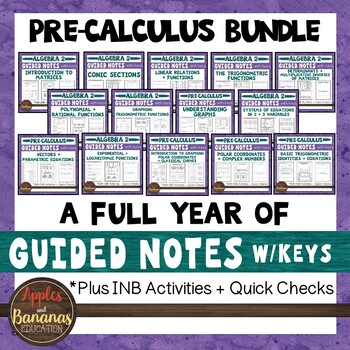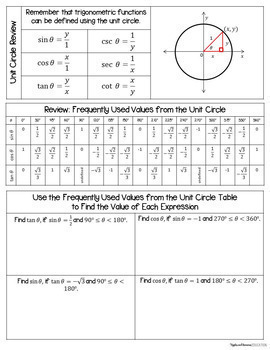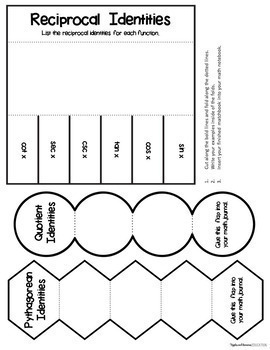Pre-Calculus Interactive Notebook Activities and Guided Notes Bundle
- Zip
What educators are saying
Products in this Bundle (14)
showing 1-5 of 14 products
Description
********* If you have purchased our Algebra 2 Bundle you already have a lot of the material contained in this packet. We have a separate small bundle of the Pre-Calculus items that are not included in the Algebra 2 Bundle so that you can purchase the additional notes for Pre-Calc that are not included in the Algebra 2 bundle.********* You can find that bundle here: Pre-Calculus Add On Bundle for Algebra 2
This HUGE (over 500 pages) Pre-Calculus bundle contains a guided/scaffolded notes, interactive foldable activities, and quick checks for understanding (exit tickets) for 14 units of study, perfect for Pre-Calculus students. There are over 145 focused note activities that contain sample teacher answer keys. Example problems are solved on the sample teacher answer keys, but you can have your students use them over and over again with problems from your own curriculum. There are over 150 interactive notebook activities which include descriptions for use. We have not included specific examples for the interactive notebook activities. We like to give them to students for review so that they can show what they have learned and personalize their notes. This product also contains over 170 quick checks for understanding that can be used as exit tickets or mini-quizzes. This bundle is perfect to use with any textbook or e-book curriculum and great for engaging all types of learners.
This bundle also contains a description of how to use the materials included.
Bundle contains the following individual units:
Linear Relations and Functions
Includes:
Relations: Domain and Range
Multiple Representations of a Relation
What is a Function?:
What do functions look like?
Create a Mapping of a Relation
Is the equation a linear equation?
State the Domain of a Function
Evaluating Functions for a Given Value
Operations with Functions
Composition of Functions
Ways to Write Equations of Lines
Writing Linear Equations in Standard Form
Types of Slope
Finding Slope
Linear Functions
Using Intercepts to Graph Lines
Graph a Line in Slope-Intercept Form
Graph a Line Given a Point and Slope
Writing Linear Equations
Equations of Parallel, Coinciding, and Perpendicular Lines
Graphing Parallel Lines
Graphing Perpendicular Lines
Correlation
Some Special Piecewise Functions
Graphing Linear Inequalities
Plus 12 Interactive Notebook foldable activities and 14 Quick Checks for Understanding
Solving Systems of Equations in Two and Three Variables
Includes:
Characteristics of Systems of Equations
What is a System of Equations?
How do you solve a system of equations by graphing?
Classifying Systems of Equations by Graphing
How do you solve a system of equations using substitution?
How do you solve a system of equations using elimination?
Multiply, Then Use Elimination
Graphing Inequalities
What is a system of inequalities?
Solving a System of Inequalities by Graphing
Solving a System of Equations (Graphing, Substitution,
and Elimination)
Systems of Equations in Three Variables
14 Steps for Solving a System of Equations in Three Variables with Elimination
9 Steps for Solving a System of Equations in Three Variables with Substitution
Plus 10 Interactive Notebook foldable activities and 7 Quick Checks for Understanding.
Includes:
What is a Matrix?
What are Equal Matrices?
Adding and Subtracting Matrices
Steps for Multiplying Matrices
Multiplying Matrices
Name that Matrix
Matrices: Special Types
The Product of a Scalar and a Matrix
Modeling Motion with Matrices
What is a Vertex Matrix/Translation Matrix?
How do you Translate a Shape using Matrices?
Reflection Matrices
Rotation Matrices
How do you Complete a Reflection or Rotation of a Shape Using a Matrix?
How do you Dilate a Shape Using a Matrix?
Plus 11 Interactive Notebook foldable activities and 8 Quick Checks for Understanding.
Determinants and Multiplicative Inverses of Matrices
Includes:
What is a Determinant?
Formula for Finding the Determinant of a 2x2 Matrix
Steps for Finding the Determinant of a 3x3 Matrix
Finding the Determinant of a 3x3 Matrix
Steps for Finding the Determinant of a 3x3 Matrix Using Diagonals
Finding the Determinant of a 3x3 Matrix Using Diagonals
Cramer's Rule for Two Variables
Cramer's Rule for Three Variables
Multiplicative Inverse of a Matrix
Solving Systems of Equations Using Matrix Equations in 4 Steps
Plus 7 Interactive Notebook foldable activities and 7 Quick Checks for Understanding.
Understanding Graphs – Math Journal Activities
Includes:
Point Symmetry/Symmetry with Respect to the Origin/Example/Non-Example
Line Symmetry (x-axis, y-axis, y=x, and y=-x)
Parent Graph (Cut and Paste)
Changes to Parent Functions
Parent Function (Match)
Are the Ordered Pairs Solutions to the Inequality?
Steps for Graphing Non-Linear Inequalities
Solving Absolute Value Inequalities
Inverse Relations/Functions
Continuous vs. Discontinuous Functions
Discontinuous Functions (Infinite, Jump, Point, and Everywhere)
How do you test for continuity?
Using the Continuity Test
Continuity on an Interval
End Behavior of Polynomial Functions
When is a function monotonic on an interval?
Increasing, Decreasing, and Constant Functions
Examining the Intervals of a Given Function
Critical Points (Cut and Paste)
Extrema (Cut and Paste)
Defining Key Terms: Asymptotes
Find the Vertical and Horizontal Asymptotes for a Graph
Using Parent Graphs to Graph New Functions
Horizontal vs. Slant Asymptote
Find the Slant Asymptote and Vertical Asymptote for a Graph
Rational Functions with a Common Factor in the Numerator and Denominator
Plus 14 Interactive Notebook foldable activities and 18 Quick Checks for Understanding.
Polynomial and Rational Functions
Includes:
Review: Finding the Degree and Leading Coefficient of a Polynomial in One Variable
Evaluating a Polynomial Function for a Given Value
Evaluating a Polynomial Function for a Variable or Algebraic Expression
Graphs of Polynomial Functions (Handout)
Graphs of Polynomial Functions Reflection
End Behavior of Polynomial Functions
Graphs of Polynomial Functions
The Fundamental Theorem of Algebra
Write a polynomial equation with the given roots.
Find the roots of a function and graph.
Locate the zeros of a function by graphing.
Finding the relative maximum and minimum by graphing.
The Location Principle
Reviewing Polynomial Factoring Techniques
Factoring Polynomials
Solving Polynomial Functions Using Quadratic Techniques
What can the discriminant of the quadratic formula tell you about the roots of the equation?
Writing Polynomial Equations in Quadratic Form
Solve a Quadratic Equation by Completing the Square
Solve a Quadratic Equation Using the Quadratic Formula
The Remainder and Factor Theorems
Using Synthetic Division to Divide a Polynomial by a Binomial
Rational Root Theorem and Descartes’ Rule of Signs
Use Descartes’ Rule of Signs and the Rational Root Theorem to Determine the Zeros of a Function
The Rational Root Theorem and Integral Zero Theorem
Use Descartes’ Rule of Signs and the Rational Root Theorem to Determine the Zeros of a Function (Leading Coefficient Does Not Equal 1)
Solving Rational Equations
Decomposing a Rational Expression into Partial Fractions
Solving Radical Equations
Solving Radical Equations with More than One Radical
Graphing a Radical Equation
Plus 23 Interactive Notebook foldable activities and 14 Quick Checks for Understanding.
Vectors and Parametric Equations
Includes:
What is a Vector? (with Sample Teacher Key)
Vector Terms (Matching) (with Teacher Key)
Types of Vectors (Define/Draw) (with Sample Teacher Key)
Methods for Adding Vectors (with Sample Teacher Key)
What is a Scalar Quantity? (with Sample Teacher Key)
Representing a Vector as an Ordered Pair (with Sample Teacher Key)
Introduction to Unit Vectors (with Sample Teacher Key)
Vector Operations in Two Dimensions (with Sample Teacher Key)
Handout: Graphing Ordered Triples in 8 Steps
Vector and Magnitude for Two Ordered Triples (with Sample Teacher Key)
Vector Operations in Three Dimensions (with Sample Teacher Key)
Inner Product-Dot Product in Two Dimensions (with Sample Teacher Key)
Inner Product-Dot Product in Three Dimensions (with Sample Teacher Key)
Using the Determinant of a 3x3 Matrix to Find the Cross Product of Vectors in Space (with Sample Teacher Key)
Using Vectors to Represent Force (with Sample Teacher Key)
More Vector Terms (Match) (with Teacher Key)
Vector Equations and Parametric Equations (with Sample Teacher Key)
Parametric Equations in Linear Forms (with Sample Teacher Key)
Projectile/Trajectory/Range (with Sample Teacher Key)
Intro: Using Parametric Equations to Find the Path of a Projectile (with Sample Teacher Key)
Writing Parametric Equations to Represent the Path of a Projectile (with Sample Teacher Key)
Representing a Point in Space as a Matrix (with Sample Teacher Key)
What is a Vertex Matrix? (with Sample Teacher Key)
What is a Translation Matrix? (with Sample Teacher Key)
Handout: How do you Translate a Three-Dimensional Shape Using Matrices?
Handout: Reflection Matrices
Handout: How do you Complete the Reflection of a Three-Dimensional Shape Using Matrices?
Handout: Review-Steps for Multiplying Matrices
Plus 13 Interactive Notebook foldable activities and 18 Quick Checks for Understanding.
Introduction to Graphing Polar Coordinates and Classical Curves
Includes:
Label the Degree Measures on the Polar Coordinate System
Label the Radian Measures on the Polar Coordinate System
Polar Coordinate System Terms (Match)
Graph a Polar Coordinate in Radians
Graph a Polar Coordinate in Degrees
How do you Graph Polar Coordinates with a
Negative Angle Value?
Multiple Representations of a Polar Coordinate (Radians)
Multiple Representations of a Polar Coordinate (Degrees)
Graphing Basic Polar Equations
Distance Formula for the Polar Plane
How to use www.desmos.com to Graph Polar Equations
Graphs of Polar Equations
Graphs of Polar Equations (Classical Curves-Rose Curve)
Graphs of Polar Equations (Classical Curves-Lemniscate Curve)
Graphs of Polar Equations (Classical Curves-Limacon Curve)
Graphs of Polar Equations (Classical Curves-Cardiod Curve)
Graphs of Polar Equations (Classical Curves-Spiral of
Archimedes Curve)
Classical Curves Overview (Cut and Paste)
Plus 5 Interactive Notebook foldable activities and 5 Quick Checks for Understanding.
Polar Coordinates and Complex Numbers
Includes:
Review of Trigonometric Values
Forms of a Linear Equation (Standard/Rectangular, Normal Form, Polar Form)
Changing Polar Coordinates to Rectangular Coordinates
Changing Rectangular Coordinates to Polar Coordinates (x is positive)
Changing Rectangular Coordinates to Polar Coordinates (x is negative)
Example: Changing a Polar Equation to Rectangular Form
Example: Changing Rectangular Form to a Polar Equation
Polar Form of a Linear Equation
Example: Changing a Polar Equation in Linear Form to Rectangular Form
Operations with Complex Numbers
Powers of i
Graphing a Complex Number
Absolute Value of a Complex Number
Polar Form of a Complex Number
Changing a Complex Number to Polar Form in 4 Steps
Graphing a Complex Number in Polar Form
Changing a Number from Polar Form to Rectangular Form
Product of a Complex Number in Polar Form
Quotient of a Complex Number in Polar Form
De Moivre’s Theorem
Steps for Finding the Power of a Complex Number
Steps for Finding the Principle Root of a Complex Number
Plus 12 Interactive Notebook foldable activities and 17 Quick Checks for Understanding.
Includes:
What is the distance formula for two points?
What is the slope formula for two points?
What is the midpoint formula for two points?
How do you cut the cones to make the conic sections?
Steps for Determining Whether a Quadrilateral with Given Vertices is a Parallelogram (Worksheet)
Equations of Circles
Draw a picture of a circle that is tangent to the x-axis.
Draw a picture of a circle that is tangent to the y-axis.
Circles: Standard Form and Graphing
Use a system of equations to find the center and radius of a circle given three points on the circle.
Ellipse: Label the Diagram
Ellipse: Equations that you need to know.
Steps for writing the equation of an ellipse in standard form when given an equation in general form.
Hyperbola: Label the Diagram
Hyperbola: Equations that you need to know.
Steps for writing the equation of a hyperbola in standard form when given an equation in general form.
Parabola: Label the Diagram
Parabola: Equations that you need to know.
Steps for writing the equation of a parabola in standard form when given an equation in general form.
General Form of a Conic Section
Identify the conic section represented by each equation.
Steps for finding a rectangular equation given a parametric equation of a conic section.
Conic Section Review Sheet (2 pages)
Solving a System of Equations in Three Variables by Substitution (Review Sheets)
Plus 12 Interactive Notebook foldable activities and 12 Quick Checks for Understanding.
Exponential and Logarithmic Functions
Includes:
Review: Properties of Exponents
Simplifying Exponential Expressions
Evaluating Exponential Expressions
Radicals and Rational Exponents
Graph an Exponential Function
Graph an Exponential Inequality
Formulas: Population Growth/Decline and Value of Investments
What is e?
Formulas: Exponential Growth/Decay (e)/Continuously Compounded Interest (e)/Compound Interest
Logarithmic Functions
Converting between Logarithmic and Exponential Functions
Properties of Logarithms
Common Logarithms
Expanding Expressions with Common Logarithms
Change of Base Formula
Using Logarithms to Solve Exponential Equations
Natural Logarithms
Converting Logarithms to Natural Logarithms
The Inverse of Ln
Formula: Doubling Time of an Investment
Plus 13 Interactive Notebook foldable activities and 14 Quick Checks for Understanding.
Includes:
Parts of an Angle (Match)
Positive and Negative Angles
Standard Position
Quadrantal Angles
Measuring Angles in Degrees, Minutes, and Seconds
Expressing Decimal Degree Measures in Degrees, Minutes, and Seconds
Determine the Angle Measure of a Clockwise Rotation Around the Coordinate Plane
Determine the Angle Measure of a Counterclockwise Rotation Around the Coordinate Plane
Coterminal Angles and Reference Angles
Which Quadrant is your Angle in?
Using Quadrants to Figure out Reference Angles
Find the Measure of the Reference Angle
Review of the Pythagorean Theorem
Find the Six Trigonometric Ratios for Angle A
Trigonometric Ratios (Sine, Cosine, and Tangent)
Reciprocal Trigonometric Ratios (Cosecant, Secant, and Cotangent)
Special Right Triangle Relationships
Trigonometric Ratios for 30°, 45°, and 60°
Cofunctions
Unit Circle on a Coordinate Plane
The Six Trigonometric Functions on the Unit Circle
Using the Unit Circle to Find Values of Trigonometric Functions
Trigonometric Functions of an Angle in Standard Position
Find the Values of the Six Trigonometric Functions for an Angle in Standard Position Given a Point on its Terminal Side
Using Trigonometric Functions to Solve Problems Involving Right Triangles
Frequently Used Values from the Unit Circle
Inverses of Trigonometric Functions
Solve an Equation Using the Inverse of Trigonometric Functions
Evaluate an Expression with an Inverse Function Multiplied by a Function
Solve a Right Triangle Using Trigonometric Ratios and the Pythagorean Theorem
The Law of Sines
Formulas for Finding the Area of Triangles (Given Two Sides and an Angle Measure)
Formulas for Finding the Area of Triangles (Given Two Angles and a Side Measure)
The Law of Cosines
Hero’s Formula
Plus 13 Interactive Notebook foldable activities and 17 Quick Checks for Understanding.
Graphing Trigonometric Functions
Includes:
Radians
Radian Measures and Their Degree Equivalents
Length of an Arc
Area of a Circular Sector
Angular and Linear Velocity
Properties of the Graph y = sin x
Properties of the Graph y = cos x
Finding the Amplitude and Period of Sine and Cosine Functions
Phase Shifts
Midline
Vertical Shifts
Graphing Sine and Cosine Functions
Properties of the Graph of y = tan x
Properties of the Graph y = cot x
Properties of the Graph y = csc x
Properties of the Graph y = sec x
Period of Trigonometric Functions
Plus 7 Interactive Notebook foldable activities and 16 Quick Checks for Understanding.
Basic Trigonometric Identities and Equations
Includes:
Unit Circle Review
Review: Frequently Used Values from the Unit Circle
Use the Frequently Used Values from the Unit Circle Table to Find the Value of Each Expression
Basic Trigonometric Identities
Match the Basic Trigonometric Identity Pairs
Using Reciprocal Identities to Find the Value of Trigonometric Functions
Finding the Value of a Trigonometric Function
Sometimes You Need to Use More Than One Identity
Symmetry Identities
Using Substitution with the Symmetry Identities
Expressing Values as Trigonometric Functions of an Angle in Quadrant I
Opposite-Angle Identities
Using Opposite Angle Identities
Beginning: Use Trigonometric Identities to Simplify Trigonometric Expressions
Advanced: Use Trigonometric Identities to Simplify Trigonometric Expressions
Verifying Trigonometric Identities
Simplifying Trigonometric Equations
Plus 7 Interactive Notebook Foldable Activities and 7 Quick Checks for Understanding.
Please see individual units for full-length previews.
These units can be used for introducing topics or to reflect/review what you have covered in class discussion. The problems listed in this activity packet build nicely on each other if introduced in the order that they appear. Our students enjoy filling them out and organizing them in their math journals so that they can refer back to them throughout the year. These activities are a great way to promote writing in math.
Related Products:
**Full-year Curriculum Packs**
Algebra 1 Curriculum Pack BUNDLE
Geometry Curriculum Pack BUNDLE
Algebra 2 Curriculum Pack BUNDLE
Scaffolded Notes/Interactive Notebook Bundles
Pre-Calculus Add on for Algebra 2 INB Bundle
High School Math Interactive Notebook Bundle (Algebra 1, Geometry, Algebra 2)
Student Practice Pages Bundles
Algebra 1 Student Practice Pages Bundle
Geometry Student Practice Pages Bundle
Algebra 2 Student Practice Pages Bundle
High School Math Student Practice Pages Bundle (Algebra 1, Geometry, Algebra 2)
Assessment Bundles
High School Math Assessment Bundle (Algebra 1, Geometry, Algebra 2)
**If you like what you see, please click on the "Follow Me" star to learn about new products, sales, and more!





